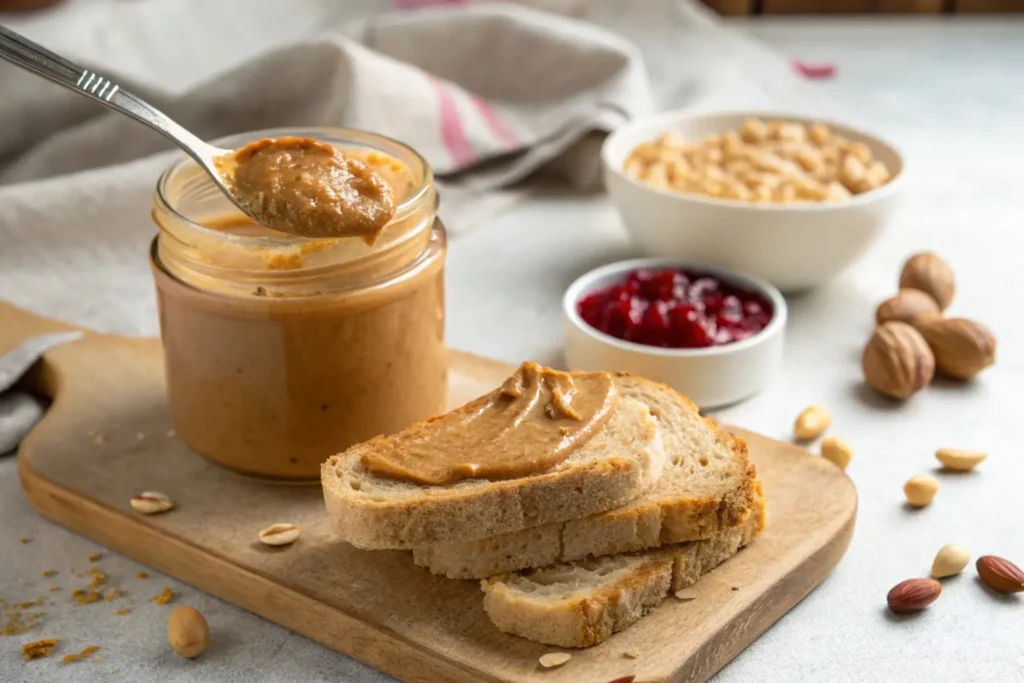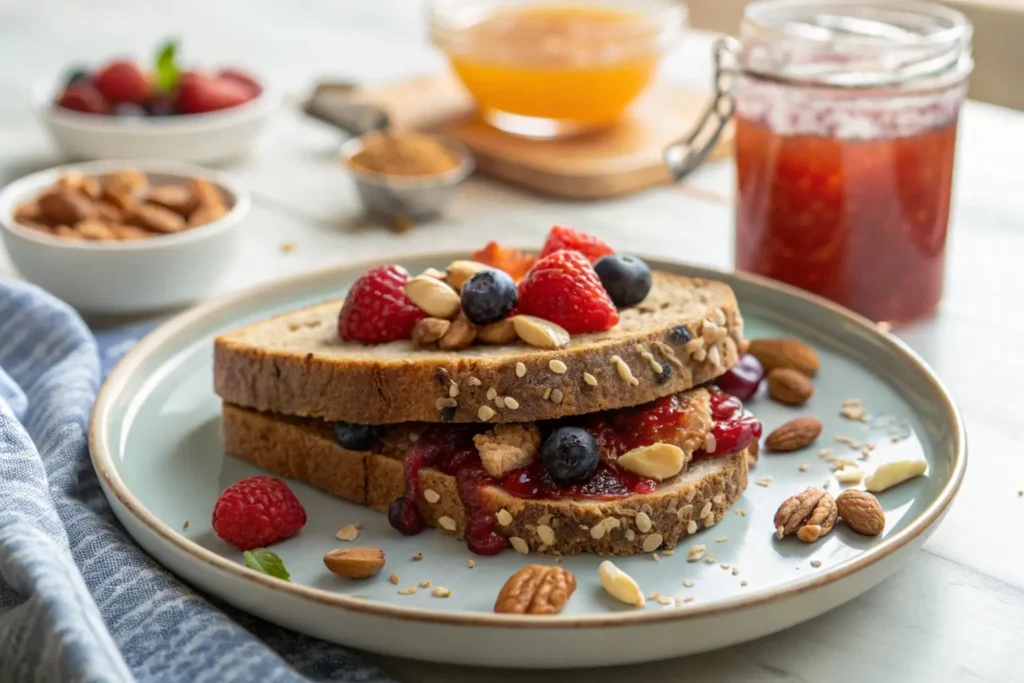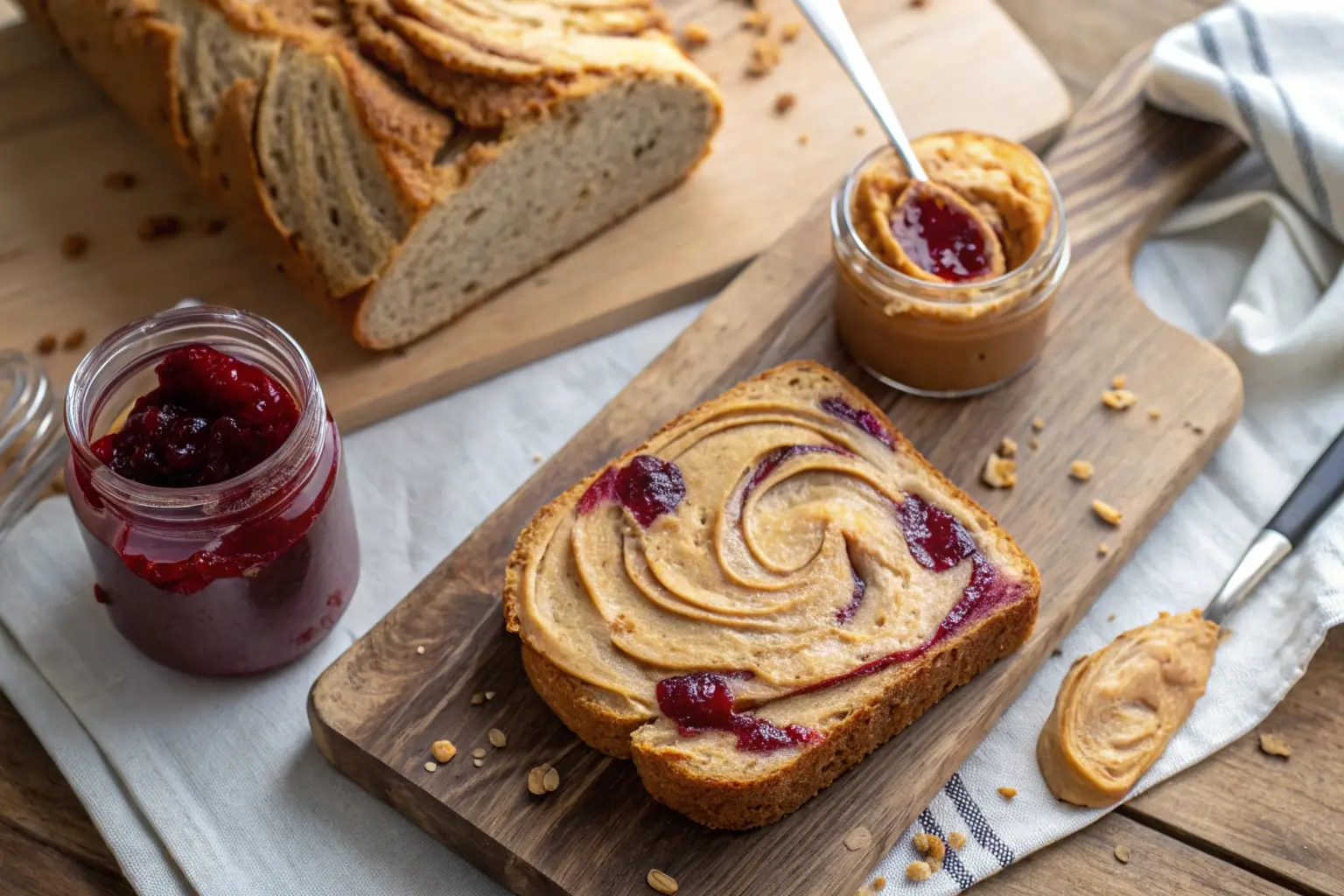Peanut butter and jelly sandwiches hold a special place in our hearts as a comforting, nostalgic treat. But did you know you can elevate this classic combo into something even more exciting and nutritious? By incorporating whole grains into your bread and exploring creative variations, you can transform a simple bread grain recipe peanut butter and jelly into a gourmet delight that satisfies both your taste buds and your health goals.
This article dives into the history, benefits, and step-by-step process of creating a bread grain recipe featuring peanut butter and jelly. We’ll also explore unique variations, nutritional benefits, and expert tips to help you perfect this recipe at home. Let’s get started!
Table of Contents
The History and Popularity of Peanut Butter and Jelly
How Peanut Butter and Jelly Became a Classic Combo
The story of the peanut butter and jelly sandwich dates back to the early 20th century, but its popularity skyrocketed during World War II. Soldiers loved the simplicity and shelf-stability of peanut butter and jelly, making it an ideal meal for the battlefield. When they returned home, this quick, nutritious option found its way into American kitchens, becoming a beloved staple for families.
Its simplicity is one reason PB&J continues to endure. With just three ingredients—bread, peanut butter, and jelly—it’s easy to make and endlessly adaptable. Over the years, creative twists like bread grain recipe peanut butter and jelly have added even more appeal, making it a timeless favorite.
The Rise of PB&J as a Global Favorite
Though it originated in the United States, PB&J has gained international acclaim. Variations of the sandwich can be found worldwide, often tailored to local flavors. In Australia, peanut butter is paired with honey, while in Indonesia, it’s enjoyed with chocolate sprinkles. Each culture puts its spin on this classic, showcasing its versatility and universal appeal.
Today, PB&J is more than just a sandwich; it’s a canvas for creativity. From grilled versions to those incorporating artisan breads, the evolution of this humble recipe continues to surprise and delight.
The Role of Bread Grains in Elevating the PB&J Experience
Whole-Grain vs. White Bread: Nutritional Benefits and Flavor
The choice of bread can make or break a bread grain recipe peanut butter and jelly. While white bread is a nostalgic classic, whole-grain bread offers unmatched nutritional benefits and depth of flavor. Whole grains are packed with fiber, essential nutrients, and a hearty texture that pairs beautifully with the creamy richness of peanut butter and the sweetness of jelly.
Unlike white bread, which is often light and fluffy, whole-grain bread has a nuttier taste and a denser crumb. This makes it perfect for supporting the weight of thick peanut butter and sticky jelly without getting soggy. Whether you’re aiming for a healthier option or simply want to enhance the taste, switching to whole-grain bread is a smart choice.
Unique Grain Options for a Gourmet Touch
Why stop at plain whole wheat? Incorporating unique grains like spelt, rye, or quinoa into your bread adds complexity and a gourmet touch. Multigrain breads that combine flaxseeds, oats, or chia seeds not only boost nutritional value but also create an intriguing texture.
These grain options can elevate a bread grain recipe peanut butter and jelly into something truly special. The slight chewiness of seeds, combined with the creamy and sweet fillings, makes each bite a delightful contrast of flavors and textures. For adventurous bakers, experimenting with ancient grains like amaranth or teff can bring even more variety to your table.
Essential Ingredients for a Perfect Bread Grain Peanut Butter and Jelly Recipe
Selecting the Best Peanut Butter for Your Recipe

Peanut butter is the star of this recipe, so choosing the right one is essential. Natural peanut butter, made with minimal ingredients, provides a creamy, rich flavor without added sugars or hydrogenated oils. Its smooth consistency works well with the grains in the bread, creating a harmonious bite every time.
For a slightly crunchier texture, consider using chunky peanut butter. The bits of peanuts add a satisfying crunch, especially when paired with whole-grain bread. If you’re looking to experiment, try almond butter or sunflower seed butter for a unique twist on the classic bread grain recipe peanut butter and jelly.
Choosing the Right Jelly, Jam, or Preserves
The jelly is where you can get creative. Traditional grape jelly is a staple, but why not branch out? Strawberry preserves, blackberry jam, or even a tart marmalade can bring a fresh burst of flavor to your recipe. If you’re aiming for a healthier option, opt for low-sugar or homemade jellies.
The type of jelly you choose should complement the grains in your bread. For example, a tangy raspberry jam pairs wonderfully with nutty, earthy whole-grain bread. The contrast in flavors creates a balanced profile, elevating your PB&J from simple to sublime.
Exploring Nut Butter Alternatives for Variety
If you or your guests have dietary restrictions, nut butter alternatives like cashew butter or soy-based spreads can be excellent substitutions. These options maintain the creaminess of traditional peanut butter while introducing new flavors.
Experimenting with ingredients lets you customize the bread grain recipe peanut butter and jelly to suit your preferences. Whether sticking with the classics or venturing into new territory, the right ingredients make all the difference in creating a memorable dish.
How to Make Bread Grain Peanut Butter and Jelly Recipes
Step-by-Step Instructions for a Classic PB&J
Creating a bread grain recipe peanut butter and jelly is straightforward but requires some planning for the best results. Here’s how to get started:
- Prepare the bread dough. Combine whole-grain flour, yeast, warm water, a pinch of salt, and a touch of honey for sweetness. Knead the dough until it’s smooth and elastic, then let it rise until doubled in size.
- Roll out the dough. Once risen, roll the dough into a rectangle. This step ensures even spreading of the peanut butter and jelly.
- Spread the fillings. Use a spatula to evenly spread peanut butter across the dough, leaving a small border around the edges. Follow with your favorite jelly or jam, spreading it in a thin layer to prevent leaks during baking.
- Roll and shape the loaf. Starting from one end, roll the dough tightly into a loaf shape. Pinch the seams to seal the roll and place it in a greased loaf pan.
- Bake to perfection. Bake at 375°F (190°C) for about 30–35 minutes or until golden brown. Allow the bread to cool before slicing.
Incorporating Grains for Enhanced Texture and Flavor
To elevate your recipe, consider mixing in grains like oats, quinoa, or flaxseeds into the dough. These additions not only boost nutrition but also add a delightful texture. Sprinkle a few on top of the loaf before baking for extra crunch and visual appeal.
Tips for Spreading Peanut Butter and Jelly Perfectly
To achieve an even spread, soften the peanut butter slightly by stirring it well. Use a back-and-forth motion to create an even layer. For jelly, warm it slightly if needed, and use a spoon to dollop it onto the dough before spreading gently.
Creative Variations of the Classic Recipe
Grilled PB&J: A Warm and Crispy Twist
For a delightful variation, try grilling your PB&J. Prepare the bread grain loaf as described above, slice it, and use the slices to make sandwiches. Grill the sandwiches in butter until the bread is golden and crispy, and the peanut butter and jelly are warm and gooey.
Adding Layers: Fruits, Nuts, or Honey for Extra Flavor
Take your bread grain recipe peanut butter and jelly to the next level by layering additional ingredients. Thinly sliced bananas, fresh strawberries, or chopped nuts can add bursts of flavor and texture. Drizzle honey for a touch of natural sweetness that pairs beautifully with whole grains.
Transforming PB&J into Breakfast or Dessert
This recipe is versatile enough to shine beyond lunch. For breakfast, toast a slice of your PB&J bread and top it with Greek yogurt and fresh fruit. For dessert, consider turning slices into French toast, served with whipped cream and a drizzle of chocolate sauce.
Nutritional Insights on Bread Grain Peanut Butter and Jelly
Protein, Fiber, and Healthy Fats from Peanut Butter and Grains
One of the standout benefits of a bread grain recipe peanut butter and jelly is its impressive nutritional profile. Whole-grain bread is packed with fiber, which aids digestion and keeps you feeling full longer. It’s also a great source of essential vitamins like B vitamins, magnesium, and iron, making it a healthier choice compared to white bread.
Peanut butter, the star ingredient, is rich in protein and healthy fats. These nutrients provide sustained energy, making this recipe an excellent option for breakfast or an afternoon snack. The combination of fiber from the bread and protein from the peanut butter creates a well-balanced meal that satisfies hunger and promotes satiety.
Low-Sugar and Organic Jelly Options for Health-Conscious Eaters
While jelly brings a delightful sweetness to this recipe, choosing the right type is crucial. Opt for low-sugar or organic options to avoid excess refined sugars. Jams made with natural fruit and minimal additives enhance the flavor of the grains and nut butter without overpowering them.
For those seeking to reduce sugar intake further, consider using mashed fresh fruit like bananas or berries as a jelly substitute. This twist not only lowers the sugar content but also adds natural vitamins and antioxidants to your bread grain recipe peanut butter and jelly.
Serving, Storing, and Customizing PB&J for All Ages
Creative Presentations for Kids and Adults

Presentation can make all the difference when serving a bread grain recipe peanut butter and jelly. For kids, cut the bread into fun shapes using cookie cutters or arrange the slices into smiley faces with fruit toppings. Adults might appreciate a more gourmet touch, such as sprinkling chia seeds or a drizzle of honey over the slices.
Serving the bread warm, freshly baked, or toasted adds another layer of enjoyment. For a party or brunch, consider serving smaller portions as part of a charcuterie board alongside nuts, fruits, and spreads.
Storage Tips to Prevent Sogginess and Maintain Freshness
Proper storage is essential to keep your bread grain loaf fresh. Allow the loaf to cool completely before wrapping it tightly in plastic wrap or storing it in an airtight container. For longer storage, slice the bread and freeze individual portions. Thaw them as needed and toast for a fresh-from-the-oven feel.
To prevent sogginess when preparing PB&J sandwiches ahead of time, spread a thin layer of peanut butter on both sides of the bread before adding the jelly. This creates a barrier that keeps the bread from absorbing moisture, ensuring a fresh and enjoyable bite every time.
FAQs About Bread Grain Peanut Butter and Jelly Recipes
What’s the Best Grain Bread for PB&J?
When choosing the best grain bread for a bread grain recipe peanut butter and jelly, whole-grain options are an excellent place to start. Whole wheat bread is a classic choice, offering a nutty flavor and a firm structure to hold the peanut butter and jelly without getting soggy. Multigrain bread, with its combination of seeds and grains like oats, flax, or quinoa, is another fantastic option for added texture and nutrition.
For those seeking a unique twist, spelt or rye bread provides a slightly tangy flavor that pairs beautifully with sweet jams and creamy peanut butter. Experimenting with different grains allows you to customize your recipe to suit your taste preferences.
How Can I Make a Gluten-Free Version?
Creating a gluten-free bread grain recipe peanut butter and jelly is easier than you might think. Start with a gluten-free bread mix or use gluten-free flours such as almond flour, rice flour, or a pre-made gluten-free flour blend. Many grocery stores also carry pre-made gluten-free breads that work well for PB&J.
If you’re baking at home, adding gluten-free grains like millet or sorghum can enhance the bread’s texture and flavor. Just ensure you’re using a binding agent like xanthan gum or psyllium husk to maintain the bread’s structure.
Can I Add Extra Protein or Fiber to PB&J?
Absolutely! Enhancing your PB&J with added protein or fiber is a great way to make it even more nutritious. Consider mixing protein powder into your peanut butter or incorporating chia seeds into your bread dough. You can also add a layer of Greek yogurt or a handful of sliced nuts for an extra protein boost.
For added fiber, flaxseeds or psyllium husk can be blended into the dough or sprinkled on top of the bread. These simple additions not only improve nutrition but also elevate the texture and taste of your bread grain recipe peanut butter and jelly.

